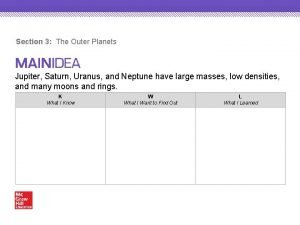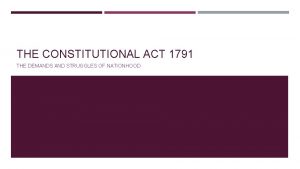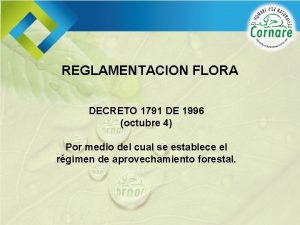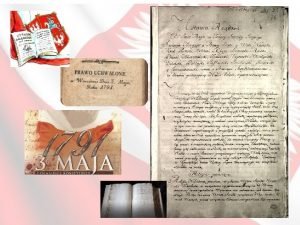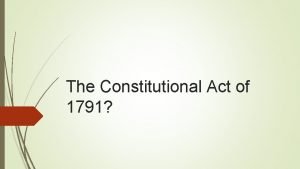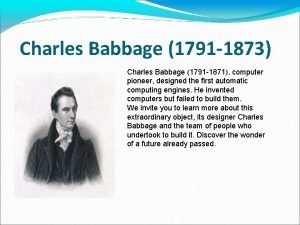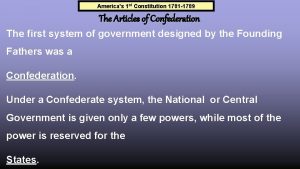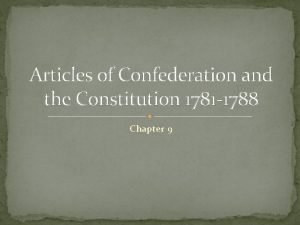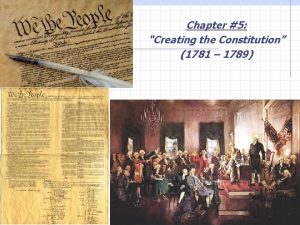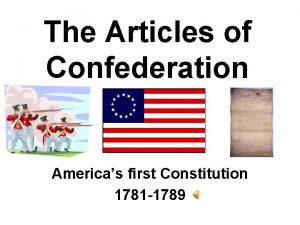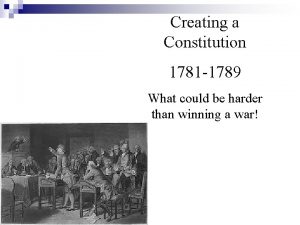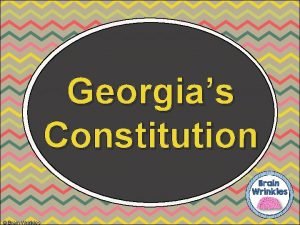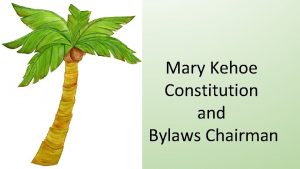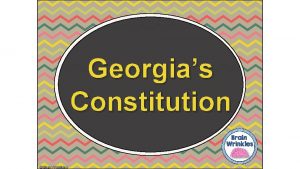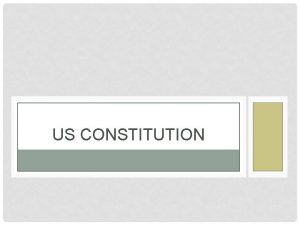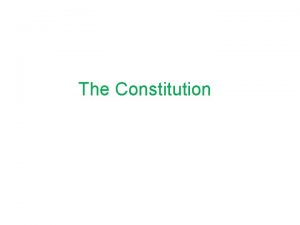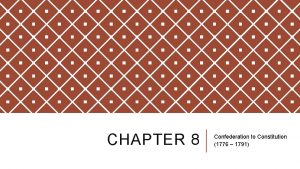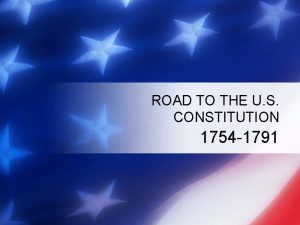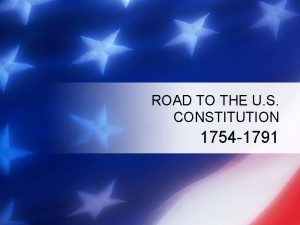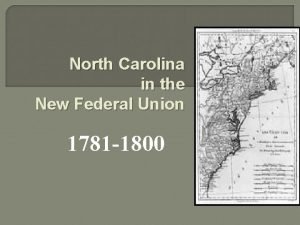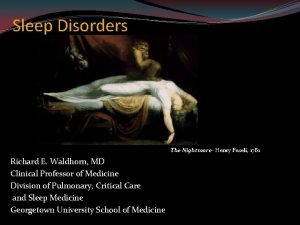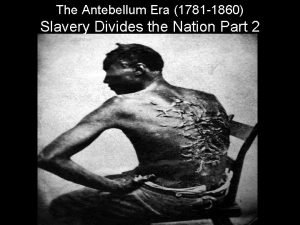The Constitution 1781 1791 The Constitution 1781 1791

















































- Slides: 49

The Constitution (1781 -1791)

The Constitution (1781 -1791) The period in American history in which the newly independent colonies sought to establish the framework of a legal government based on revolutionary ideals in order to establish stability while maintaining individual liberty. • Liberty vs. Order

The Constitution (1781 -1791) Articles of Confederation (1781 -1789) Shay’s Rebellion (1786) Constitutional Convention (1787) Ratification Debates (1787 -1788) Bill of Rights (1791)

Articles of Confederation (1781 -1789) • The first written plan of republican government of the United States of America. • Created a “loose-alliance” among states. • Weak central government, strong state governments. • Reflected a fear of a strong central government that led to the American Revolution (Liberty vs. Tyranny)

Articles of Confederation The central government couldn’t do much: • Only 1 branch of government, which was a Unicameral Congress (Legislature) • No power to tax! • No standing Army/Navy! • Could not regulate interstate trade. • 9/13 states needed to pass a law. • 13/13 to amend the Articles of Confederation

Articles of Confederation The Articles did do a few notable things: • Allowed for a “functioning” government during and following the American Revolution. • Allowed for the Treaty of Paris (1783) to be ratified • Northwest Ordinance (1787) – Organized the new American northwest into territories that would eventually become the states of OH, IN, IL, MI, WI; and prohibited slavery in these territories.

Northwest Ordinance (1787) Admission of territories into states. • 60, 000 settlers needed.

Articles of Confederation Shay’s Rebellion (1786) – A rebellion of Massachusetts farmers due to foreclosures of farms. Rival state currencies and the ability of Congress not to regulate interstate commerce forced desperate farmers to seize a court house. • 5 people died! • Led by Revolutionary War veteran Daniel Shay. • This event highlighted the weaknesses of the Articles of Confederation and the need for change.

Shay’s Rebellion (1786)

Constitutional Convention (1787) • A secret meeting in Philadelphia from May to September in order to fix or revise the Articles of Confederation. • 12/13 States sent delegates. RI did not attend. • Delegates debated as factions or groups over issues of the newly independent country.

Constitutional Convention The convention quickly turned to drafting a new and improved government with a stronger central government powers. • Compromise = agreement • Large states vs. Small states? • North vs. South? • Central or State authority? Two main compromises would emerge…

Constitutional Convention Great Compromise = Connecticut Compromise • Agreement centered around Congressional Representation. • Bicameral Congress 1. House of Representatives (population) 2. Senate (equal representation)

Constitutional Convention

Constitutional Convention 3/5 th Compromise – Slavery & Representation • Southern States – Slaves should count toward a state’s total population to determine representation. • Fugitive Slave Clause – Escaped slaves should be returned to their respective owners. • Northern States – Slaves, who are not citizens, but rather property should not be counted toward a state’s population. • The importation of slavery would be prohibited 20 years after ratification of the constitution (1808).

Constitutional Convention Agreement centered around a fixed number to count slaves and tax slave owners on their property. 3/5 ths = 60%

Constitutional Convention Other compromises included were: • Creation of the Electoral College to elect the president (Direct or Indirect Elections) • Commerce Compromise (Tariffs on imports)

Constitutional Convention On September 17, 1787, 38 men from twelve states signed the document called the “Constitution. ” • In order for it to replace the Articles of Confederation, 9/13 states were need to ratify the constitution.

Ratification Debates In order for it to replace the Articles of Confederation, 9/13 states were need to ratify the constitution. • Two groups emerged: 1. Federalists – For the Constitution 2. Anti-Federalists – Against the Constitution.

Ratification Debates Federalists wanted to quickly ratify the constitution because it represented a stronger national government. • They supported a Preamble with 7 Articles. • To support ratification, they wrote 85 essay called the Federalist Papers.

Ratification Debate Anti-Federalists were against ratification because they feared a stronger system of government that could potentially abuse their rights. • They demanded that a “bill of rights” be included.

Ratification Debate On June 21, 1788, New Hampshire became the 9 th state to ratify the constitution. E Pluribus Unum = Out of many One.

The Constitution is the supreme law of the land. It’s like an essay that contains three parts: 1. Preamble – “We the People…” 2. 7 Articles; Articles I, III, and V are the most important. 3. 27 Amendments – changes or additions.

Constitutional Principles are guiding elements that allows this constitution to work. • Popular Sovereignty • Limited Government • Federalism • Flexibility

Constitutional Principles: Popular Sovereignty – The power to govern comes from the people. • Declaration of Independence – “Consent of the governed. ” • Constitution – “We the People…” • Congress – members are elected directly by the people.

Constitutional Principals: Limited Government • Separation of Powers – The creation of three co-equal branches designed to prevent the concentration of power into one branch. • Checks & Balances – Enumerated powers divided among three branches in order to prevent one branch from assuming too much power.


Constitutional Principles: Limited Government Bill of Rights – The first 10 Amendments added to the constitution that protect peoples’ rights from government.

Constitutional Principles: Flexibility – How can a government adapt to a changing world? Amendments – Formal changes or additions to the constitution. • Incorporates both Federalism and limited government. Interpretation – broadening or narrowly shaping the law to meet the peoples’ needs as it applies to a nation’s problems.

Constitutional Principles: Federalism – The division of power between the national and state government. • Allows layers of democracy because each government is responsive to the people on a regional level. • Each government has a distinct role.

Constitution Preamble – is the introduction that states the goals of the constitution. “We the People of the United States, in Order to form a more perfect Union, establish Justice, insure domestic Tranquility, provide for the common defence, promote the general Welfare, and secure the Blessings of Liberty to ourselves and our Posterity, do ordain and establish this Constitution for the United States of America. ”

Constitution Article I = Legislative Branch = Congress = make laws Powers include: 1. Levy Taxes. 2. Raise and support an Army/Navy 3. Coin money 4. Establish immigration policy 5. Declare war 6. Regulate interstate commerce

Constitution Article I = Congressional Qualifications • House of Representatives: 1. Elected every 2 years 2. Must be 25 years old 3. Must be a citizen for 7 years 4. Must be a resident of the state the are elected. • Senate: 1. Elected every 6 years 2. Must be 30 years old 3. Must be a citizen for 9 years 4. Must be a resident of the state they are elected.

Constitution Article II – Executive Branch = President & VP = Enforce laws Powers include: 1. Commander-in-Chief 2. Pardon 3. Appoint Judges 4. Veto laws

Constitution Article II – Presidential Qualifications 1. Elected every 4 years with a maximum of 2 terms. 2. Must be 35 years old 3. Must be a “naturally born citizen. ” 4. Must be a citizen for 14 years 5. Vice President must have residency in a different state than the president.

Constitution Article III – Judicial Branch = Supreme Court = Interpret laws Powers include: 1. Original jurisdiction 2. Appellate jurisdiction • Judicial Review

Constitution Article III – Supreme Court Qualifications 1. Life tenure

Constitution Article V – Amendment Process • An Amendment is a formal change or addition to the constitution. • Two step process: 1. 2/3 rds vote of bicameral congress. 2. 3/4 ths State ratification of state legislatures.

Bill of Rights The Bill of Rights are the first 10 Amendments added to the constitution that protect citizens from government abuse. • Supported by Anti-Federalists who wanted to limit the central/national government. • Drafted in NYC and ratified on December 15, 1791.

Bill of Rights 1 st Amendment – Freedom of expression. 2 nd Amendment – Right to bear arms. 4 th Amendment – Protection from unreasonable searches & seizures. 5 th Amendment – Rights of the accused. 6 th Amendment – Rights during criminal proceedings. 8 th Amendment – Protection from cruel & unusual punishment. 9 th Amendment – Reserved liberties for the people. 10 th Amendment – Reserved powers for States.

Bill of Rights All aspects of the constitution are suspect to interpretation and are not absolute. The Supreme Court is the primary arbiter of the constitution, however, all elected officials “interpret” the document as they seek to perform their constitutional function. • Time & Place • Beliefs vs. Actions • National security concerns

Bill of Rights 1 st Amendment:

Bill of Rights • 2 nd Amendment:

Bill of Rights 4 th Amendment:

Bill of Rights 5 th Amendment:

Bill of Rights 6 th Amendment:

Bill of Rights 8 th Amendment:

Bill of Rights 9 th Amendment:

Bill of Rights 10 th Amendment:

Essential Questions: 1. Why is having a government important? 2. If given the choice, would you rather have an all powerful government or a limited government? Explain. 3. Compare and contrast the Articles of Confederation and the Constitution? 4. Was the Bill of Rights necessary as the Anti. Federalists proposed or unnecessary as Alexander Hamilton believed? Explain. 5. Which Amendment in the Constitution is the most important? Explain.
 Bolzano (1781 – 1848)
Bolzano (1781 – 1848) Uranus was discovered accidentally in 1781
Uranus was discovered accidentally in 1781 Lesson 1 principles of the constitution
Lesson 1 principles of the constitution Texas constitution vs u.s. constitution venn diagram
Texas constitution vs u.s. constitution venn diagram Nc constitution vs us constitution
Nc constitution vs us constitution Constitution what is constitution
Constitution what is constitution Constitutional act 1791
Constitutional act 1791 Karls tomass mocarts mūziķis
Karls tomass mocarts mūziķis 1791-1756
1791-1756 1756-1791
1756-1791 Wolfgang amadeus mozart 1756-1791
Wolfgang amadeus mozart 1756-1791 Decreto 1791 del 4 de octubre de 1996
Decreto 1791 del 4 de octubre de 1996 Adam stanisław krasiński konstytucja 3 maja
Adam stanisław krasiński konstytucja 3 maja Constitutional act of 1791
Constitutional act of 1791 Monarchie constitutionnelle 1791
Monarchie constitutionnelle 1791 Cái miệng bé xinh thế chỉ nói điều hay thôi
Cái miệng bé xinh thế chỉ nói điều hay thôi Các châu lục và đại dương trên thế giới
Các châu lục và đại dương trên thế giới Bổ thể
Bổ thể Từ ngữ thể hiện lòng nhân hậu
Từ ngữ thể hiện lòng nhân hậu Tư thế ngồi viết
Tư thế ngồi viết Thế nào là giọng cùng tên?
Thế nào là giọng cùng tên? 101012 bằng
101012 bằng Thể thơ truyền thống
Thể thơ truyền thống Hát lên người ơi alleluia
Hát lên người ơi alleluia Khi nào hổ mẹ dạy hổ con săn mồi
Khi nào hổ mẹ dạy hổ con săn mồi đại từ thay thế
đại từ thay thế Diễn thế sinh thái là
Diễn thế sinh thái là Vẽ hình chiếu vuông góc của vật thể sau
Vẽ hình chiếu vuông góc của vật thể sau Cong thức tính động năng
Cong thức tính động năng Thế nào là mạng điện lắp đặt kiểu nổi
Thế nào là mạng điện lắp đặt kiểu nổi Tỉ lệ cơ thể trẻ em
Tỉ lệ cơ thể trẻ em Lời thề hippocrates
Lời thề hippocrates Vẽ hình chiếu đứng bằng cạnh của vật thể
Vẽ hình chiếu đứng bằng cạnh của vật thể độ dài liên kết
độ dài liên kết Quá trình desamine hóa có thể tạo ra
Quá trình desamine hóa có thể tạo ra Các môn thể thao bắt đầu bằng tiếng nhảy
Các môn thể thao bắt đầu bằng tiếng nhảy Hát kết hợp bộ gõ cơ thể
Hát kết hợp bộ gõ cơ thể Khi nào hổ mẹ dạy hổ con săn mồi
Khi nào hổ mẹ dạy hổ con săn mồi điện thế nghỉ
điện thế nghỉ Các loại đột biến cấu trúc nhiễm sắc thể
Các loại đột biến cấu trúc nhiễm sắc thể Biện pháp chống mỏi cơ
Biện pháp chống mỏi cơ Trời xanh đây là của chúng ta thể thơ
Trời xanh đây là của chúng ta thể thơ Voi kéo gỗ như thế nào
Voi kéo gỗ như thế nào Thiếu nhi thế giới liên hoan
Thiếu nhi thế giới liên hoan Fecboak
Fecboak Một số thể thơ truyền thống
Một số thể thơ truyền thống Thế nào là hệ số cao nhất
Thế nào là hệ số cao nhất Lp html
Lp html Sơ đồ cơ thể người
Sơ đồ cơ thể người Tư thế ngồi viết
Tư thế ngồi viết

